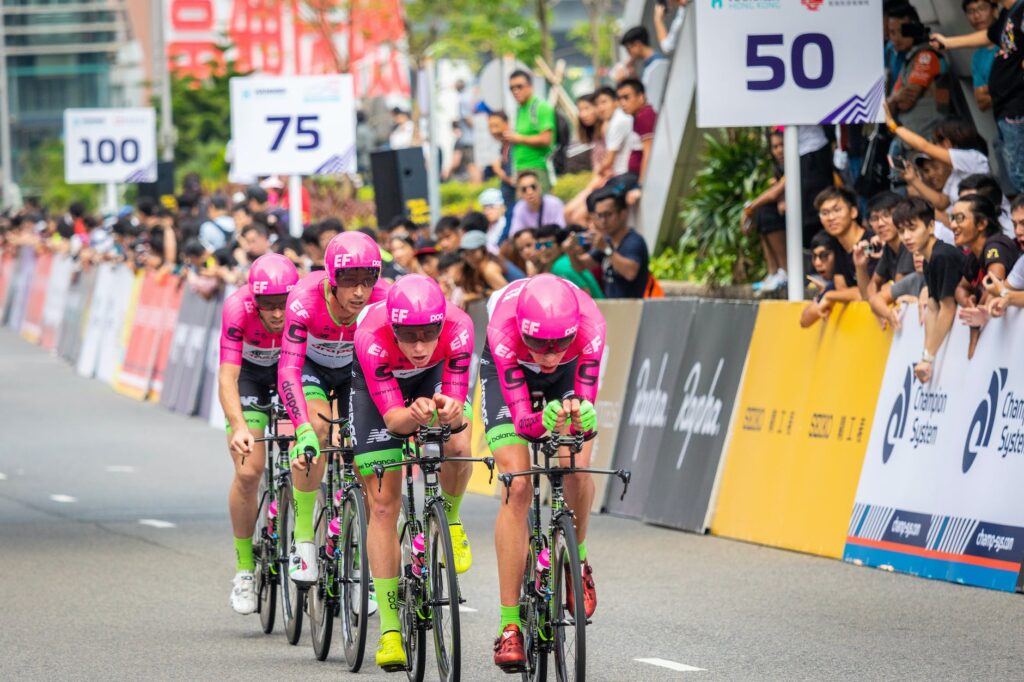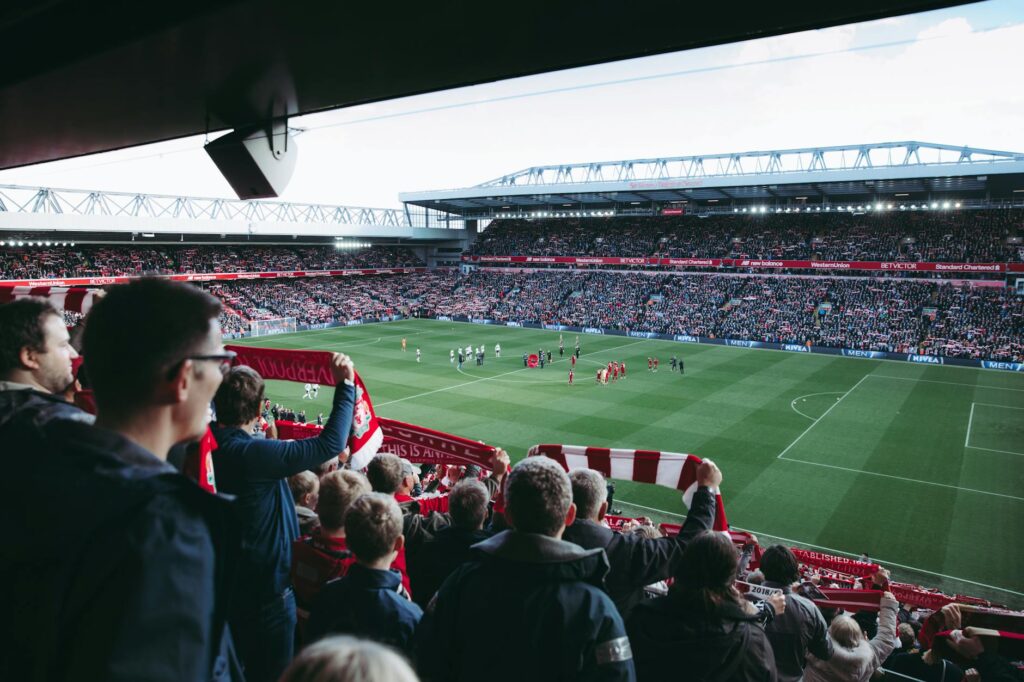Gross impressions play a crucial role in sports marketing, helping brands reach and engage with their target audience.
In this article, we will explore the fundamental concepts of gross impressions and how they impact the effectiveness of marketing campaigns in the sports industry.
Key Takeaways:
- Gross impressions are a key metric for evaluating the reach and frequency of brand messages in sports marketing.
- Sports media can help generate gross impressions and maximize exposure for campaigns.
- Strategic media planning is necessary for achieving optimal reach and frequency of brand messages and improving the effectiveness of sports marketing campaigns.
- Ad impressions in sports marketing play a significant role in driving gross impressions and evaluating the success of campaigns.
- Gross impressions also directly impact brand recognition and fan engagement, leading to a more loyal and passionate fanbase.
Understanding Gross Impressions in Sports Marketing
At its core, gross impressions are a measure of the total number of times an advertising message is seen by a target audience. In sports marketing, gross impressions play a critical role in evaluating the reach and frequency of brand messages, making it a fundamental metric for success.
To better understand gross impressions, it’s essential to define how they’re measured in sports marketing.
Typically, this metric is calculated based on the estimated size of the target audience, along with the total number of times they’re exposed to the advertising message. By multiplying these two figures, we arrive at the gross impressions count.
While there are various ways of tracking gross impressions, sports marketers often rely on data-driven insights and targeted advertising campaigns to maximize their impact. This approach helps them reach the right audience and effectively communicate their brand messages for increased returns on investment.
In conclusion, understanding gross impressions is critical for sports marketers looking to improve the performance of their marketing campaigns. By measuring this metric accurately and utilizing data-driven analytics tools, they can achieve optimal reach and frequency of brand messages, driving better engagement and improving overall marketing effectiveness.
Leveraging Sports Media for Maximum Exposure
Sports media presents a unique opportunity for sports marketers to generate gross impressions through widespread public exposure. By effectively utilizing various channels such as television, brands can improve visibility and reach their target audience in a dynamic and engaging way.
Television exposure offers an unparalleled platform to showcase the brand message to millions of sports fans across the country and globally. Placing well-crafted ads and other content during major sporting events can lead to increased brand recognition, ad recall, and positive brand association among avid sports enthusiasts.
Top-tier brands such as Nike, Coca-Cola, and Adidas have successfully leveraged sports media to generate high gross impressions and popularize their brand among consumers. Consistent exposure through well-placed ads ensures constant brand visibility that can pay dividends in the long run.
To sum up: sports media is an essential tool for sports marketers seeking to achieve maximum exposure and generate high gross impressions for their brand. By consistently utilizing television exposure, sports marketers can improve brand recognition and build strong relationships with the avid fanbase.
Maximizing reach and frequency through strategic media planning
Strategic media planning is vital in ensuring that sports marketing campaigns reach their target audience with the desired frequency. By carefully planning and allocating resources, marketers can effectively enhance gross impressions and improve the overall effectiveness of their campaigns.
One effective strategy is to target the right audience through the most appropriate media platforms. This involves understanding the demographics and preferences of the target fanbase and selecting mediums that are most likely to resonate with them. In addition, it is important to diversify media channels to increase reach and frequency. For example, combining TV exposure with social media campaigns can significantly increase visibility and reach the desired audience.
Another important consideration in media planning is the timing of campaigns. By understanding the sports calendar and the key events that drive fan engagement, marketers can strategically schedule campaigns to maximize impact and generate higher gross impressions. Additionally, leveraging partnerships with sports teams or athletes can also enhance reach and frequency by associating the brand with established and well-known sports personalities.
Overall, strategic media planning is fundamental to achieving optimal gross impressions in sports marketing. By prioritizing audience targeting and media diversification, as well as strategically timing campaigns, savvy marketers can ensure their campaigns effectively reach and engage fans while achieving desired outcomes.
The power of ad impressions in sports marketing
Ad impressions are a vital component of sports marketing that contribute significantly to gross impressions. They refer to the number of times a particular ad is displayed to a viewer. The more ad impressions a brand’s marketing campaign generates, the more opportunities it has to engage the audience and establish brand recognition.
There are several ways to track ad placements, including impression-based metrics such as the cost per impression (CPM) and cost per thousand (CPM). These metrics provide valuable insights on how effectively ads are reaching their target audience, determining which campaign strategy is viable.
Ad impressions also play a crucial role in measuring the success of marketing campaigns. By analyzing the number of ad impressions generated, brands can monitor the effectiveness of ad placements and refine their approach to increase their reach.
How ad impressions contribute to gross impressions
Gross impressions refer to the total number of times a particular message is seen by potential customers. In sports marketing campaigns, this metric is a critical factor in measuring campaign effectiveness. Ad impressions are a significant component that contributes to gross impressions, making them indispensable to a brand’s overall marketing strategy.
When a brand generates more ad impressions, it increases its chances of reaching a broader audience. Targeted ad placements that generate high ad impressions can result in an increased number of individuals exposed to a brand’s message, creating a larger gross impression. This can help maximize the efficiency of a campaign and increase its efficacy, generating a higher ROI and brand recognition.
Best practices for utilizing ad impressions in sports marketing
The key to achieving maximum benefits from ad impressions is a strategic approach to media planning. To that effect, brands should pay careful attention to the following best practices:
- Understanding the target audience and maximizing the relevance of each ad impression.
- Partnering with relevant sports teams, leagues, and athletes to increase exposure.
- Utilizing data-driven insights to optimize ad placement and generate higher ad impressions.
By consistently implementing these best practices, brands can improve their ad performance, increasing their gross impressions and driving brand recognition in their target market.
Evaluating Ad Performance in Sports Marketing
Tracking ad performance in sports marketing is crucial for brands to measure the effectiveness of their campaigns. There are several metrics and techniques used for evaluating ad performance and generating gross impressions.
Ad Tracking
Ad tracking helps to determine how many people viewed an ad and their response to it. It involves monitoring the frequency with which ads are displayed and their impact on the target audience. This metric is measured through specialized software and a series of algorithms to gather data on ad performance.
Ad Performance Metrics
The most commonly used ad performance metrics in sports marketing are impressions, click-through rates, and conversion rates. Impressions measure the number of times an ad appears on a screen, while click-through rates measure the number of clicks on an ad. Conversion rates measure how many clicks lead to the desired action, such as a purchase.
Techniques for Improving Ad Performance
Brands can improve the performance of their ads by targeting the right audience, creating compelling visuals and messages, and using data-driven insights to customize their campaigns. It is important to experiment with different ad formats and creative elements to determine which ones generate the highest gross impressions and drive desired outcomes.
| Ad Performance Metric | Definition |
|---|---|
| Impressions | The number of times an ad appears on a screen |
| Click-through rates | The number of clicks on an ad |
| Conversion rates | The number of clicks that lead to the desired action |
By tracking ad performance and using relevant metrics, brands can evaluate the effectiveness of their campaigns and optimize their strategies to generate higher gross impressions.
Careful attention to ad performance can result not only in increased brand recognition, but also in deeper engagement with the passionate sports fanbase. Updating the ad inventory is key for a successful campaign.
The Impact of Gross Impressions on Brand Recognition
In sports marketing, the number of gross impressions generated by a campaign can significantly impact a brand’s recognition and overall awareness among fans. With higher gross impressions, a brand’s message is more frequently received by the target audience, increasing the likelihood of brand recall and recognition. As a result, gross impressions play a critical role in maximizing the effectiveness of sports marketing strategies.
Research suggests that gross impressions and brand recognition have a direct correlation in sports marketing. A study conducted by SportsBusiness Journal found that higher gross impressions resulted in a more significant increase in brand recognition among avid fans compared to traditional advertising channels.
For sports marketers, understanding the relationship between gross impressions and brand recognition is essential in developing effective marketing strategies. By creating campaigns that generate higher gross impressions and strategically targeting the intended audience, brands can build brand recognition and awareness among sports fans.
The Power of Strategic Partnerships
By partnering with sports teams or athletes that have a significant following, brands can leverage their popularity to increase gross impressions and build brand recognition. The well-thought-out placement of branding elements within the sports environment can empower increased brand recognition and visibility. Notably, just like an advertisement in media, placement within sports is crucial to generating awareness.
One example of a successful partnership in sports marketing is Mercedes-Benz’s collaboration with the National Football League (NFL). By signing a sponsorship agreement with the league, Mercedes-Benz gained significant exposure within the sports environment, generating over 400 million gross impressions during the campaign.
| Brand | Gross Impressions | Partnership/Event |
|---|---|---|
| Mercedes-Benz | 400 Million | National Football League (NFL) |
| Coca-Cola | 3.2 Billion | International Olympic Committee (IOC) |
Table: Gross Impressions Generated by Brands through Strategic Partnerships
The success of Mercedes-Benz’s collaboration with the NFL demonstrates how targeted partnerships can significantly increase gross impressions, resulting in higher brand recognition and awareness. It highlights the power of leveraging sports environments and their fanbase to amplify brand messaging effectively.
Driving Fan Engagement Through Gross Impressions
In sports marketing, gross impressions can be a valuable tool for driving fan engagement. Higher gross impressions can result in increased fan interaction with marketing campaigns, leading to a more loyal and passionate fanbase.
By utilizing advertising and media channels strategically, sports marketers can generate more gross impressions and reach audiences on a larger scale. This can result in increased engagement with fans and increased brand recognition.
For example, when a sports team partners with a popular athlete and features them in their marketing campaigns, they can generate more gross impressions and reach a wider audience of fans. This can lead to increased fan engagement, as fans are more likely to connect with a campaign that features a recognizable athlete.
Case Study: Nike and the Colin Kaepernick Campaign
“Believe in something, even if it means sacrificing everything.” – Colin Kaepernick
| Metrics | Results |
|---|---|
| Gross Impressions | Over 6 billion |
| Engagement (Social Media) | Over 5 million interactions |
| Sales | $163 million (13% increase from previous year) |
In 2018, Nike launched a campaign featuring former NFL quarterback Colin Kaepernick as its spokesperson. The campaign generated over 6 billion gross impressions and over 5 million social media interactions, driving fan engagement and brand recognition. Despite backlash and controversy surrounding the campaign, Nike saw a 13% increase in sales compared to the previous year.
This case study demonstrates how the strategic use of gross impressions in sports marketing can lead to increased fan engagement and ultimately, increased revenue.
Overall, by understanding and effectively utilizing gross impressions, sports marketers can drive fan engagement and elevate their marketing strategies to new heights.
Case studies of successful sports marketing campaigns
In this section, we will take a closer look at real-life examples of successful sports marketing campaigns utilizing gross impressions. These case studies showcase how brands can maximize their reach and engagement with the avid fanbase by strategically leveraging gross impressions in their marketing strategies.
Nike
“Winner stays” – Nike Football
Nike’s “Winner Stays” campaign aimed to tap into the passion and competitive spirit of football fans around the world. The campaign featured a star-studded line-up of football icons, including Cristiano Ronaldo, Neymar Jr., and Wayne Rooney.
The campaign ran on multiple platforms, with a series of ads that were broadcast on social media, television, and cinemas. The ads were designed to go viral and encourage users to share and engage with the campaign through various social media channels. The “Winner Stays” video received over 100 million views on YouTube and was shared by over 1.4 million users on Facebook alone.
The use of gross impressions to measure the success of the campaign was critical. Nike showed how a comprehensive strategy that incorporates gross impressions can lead to a significant improvement in brand recognition and engagement amongst the fanbase.
Adidas
“The Greenest Football Club” – Adidas
In another high-impact campaign, Adidas focused on engaging loyal football fans with the Greenest Football Club (GFC). The campaign featured training sessions, coaching clinics, and event programming designed to encourage eco-friendliness.
The campaign was hosted across numerous social media channels and platforms alongside interactive in-store displays. The use of gross impressions achieved impressive results, with Adidas generating a total of 50 million gross impressions.
By combining a passion for football, eco-friendliness, and a deep understanding of their target audience, Adidas’s use of gross impressions ensured that a message was delivered that resonated with their audience and reinforced their brand identity.
NBA
“This is why we play” – NBA
The NBA’s “This is why we play” campaign successfully showcased the excitement and passion of basketball, both on and off the court. The campaign showcased real stories, moments, and experiences that truly captured the essence of the excitement, community, and pride found in the world of basketball.
The NBA realized that gross impressions played a vital role in the campaign’s success. By targeting the fanbase through broad channels, such as TV, print ads, and social media, the NBA was able to achieve nearly five billion gross impressions.
The NBA’s use of gross impressions proved that carefully targeted marketing campaigns, leveraging a fanbase’s enthusiasm and passion for the sport, could elevate brand recognition and lead to massive engagement and loyalty.
These case studies represent how gross impressions can prove to be a truly effective tool in the hands of sports marketers. By carefully planning and executing marketing strategies based around gross impressions, brands can successfully engage with their fanbase, elevate their brand, and grow their audiences.
Best practices for maximizing gross impressions in sports marketing
To achieve success in sports marketing, it is crucial to effectively harness the power of gross impressions. Here are some best practices to help sports marketers maximize their use of gross impressions:
1. Define your target audience
Understanding your target audience is a fundamental aspect of any successful marketing campaign. By defining your audience, you can tailor your messaging to appeal to their specific interests and needs, resulting in higher engagement and increased gross impressions.
2. Utilize data-driven insights
Data analysis is key to measuring the effectiveness of your marketing efforts. By leveraging data-driven insights, you can better understand the impact of your campaigns and adjust your strategies to optimize gross impressions.
3. Leverage partnerships with sports teams or athletes
Partnering with sports teams or athletes can significantly enhance your brand’s credibility and visibility. By collaborating with well-known sports entities, you can tap into the passion and loyalty of their fanbase, resulting in increased gross impressions and greater brand recognition.
4. Optimize your media mix
The media mix you choose to employ can have a significant impact on your gross impressions and overall reach. By strategically utilizing a combination of channels such as television, social media, and digital advertising, you can maximize the exposure of your campaigns and generate higher gross impressions.
| Tip | Example |
|---|---|
| Emphasize quality over quantity | Focus on delivering compelling, well-crafted content that resonates with your audience. Don’t sacrifice quality for the sake of generating more gross impressions; instead, concentrate on building authentic connections with your audience. |
| Use gamification to drive engagement | Consider implementing games, contests, or other interactive experiences to increase engagement and generate more gross impressions from your audience. |
| Track your metrics regularly | Regularly monitoring your metrics allows you to better understand the behaviour of your audience and adjust your strategies as needed to generate more gross impressions |
By following these best practices and staying updated on emerging trends in sports marketing, you can leverage gross impressions to increase the visibility and success of your campaigns.
The future of gross impressions in sports marketing
As technology continues to advance, the future of measuring and leveraging gross impressions in sports marketing looks bright. With the ever-increasing use of social media platforms, brands can now reach a larger audience and generate higher gross impressions than ever before.
Augmented reality and virtual reality are becoming crucial tools in the sports industry, especially in enhancing fan experiences. The use of these technologies creates more opportunities for brands to deliver targeted marketing messages to their intended audience, leading to increased gross impressions.
The Rise of Data-Driven Insights
Data-driven insights are playing a critical role in the future of sports marketing. Brands can now leverage data analytics and statistical methods to evaluate user behavior and preferences accurately. This ability enables them to deliver more tailored marketing messages, which translate into higher gross impressions.
Moreover, with the rise of Artificial Intelligence, machine learning algorithms can further refine the marketing message to increase reach and frequency. AI can identify trends that are not apparent to the human eye, resulting in even higher gross impressions.
The Importance of Partnerships
Partnerships between sports teams, athletes, and brands can also play an essential role in generating higher gross impressions in the future. The use of endorsements and sponsorships creates more opportunities for brands to get in front of their target audience.
Furthermore, partnerships ensure that brands have access to critical information about fans, such as demographics, preferences, and fan behaviors. This information can help brands devise more targeted marketing strategies resulting in increased gross impressions.
The Future of Gross Impressions
The future of gross impressions in sports marketing looks bright. Brands can look forward to leveraging emerging technologies, data-driven insights, and strategic partnerships to increase their gross impressions further.
However, with the rise of privacy concerns, brands must strike a careful balance between maximizing gross impressions and respecting users’ privacy. As we move forward, it’s crucial for brands to put the fan’s interests at the forefront of their marketing strategies while still achieving high gross impressions.
Conclusion
In conclusion, understanding and utilizing gross impressions is a critical element of achieving success in sports marketing. As discussed, gross impressions play a vital role in evaluating the reach and frequency of brand messages, maximizing exposure through strategic media planning, driving fan engagement, and impacting brand recognition. By following best practices and leveraging data-driven insights, brands can effectively utilize gross impressions to achieve their marketing goals and stay ahead of the curve in the ever-evolving sports industry.
As more advancements are made in technology and consumer behavior continues to evolve, the use of gross impressions in sports marketing will undoubtedly continue to play a vital role. Brands that prioritize the measurement and utilization of gross impressions will have a competitive edge in reaching the passionate fanbase and driving success in the dynamic world of sports marketing.
FAQ
Why are gross impressions important for the success of sports marketing?
Gross impressions are important for the success of sports marketing because they provide a measure of the total audience reached by a marketing campaign. They help brands understand the overall impact and effectiveness of their marketing efforts in terms of exposure to potential customers.
What are gross impressions in sports marketing?
Gross impressions in sports marketing refer to the total number of times an advertisement or brand message is viewed by the target audience. They encompass both unique viewers and repeat viewers, providing a comprehensive picture of the reach and frequency of the marketing campaign.
How can sports media contribute to maximum exposure and gross impressions?
Sports media, such as television, plays a crucial role in generating maximum exposure and gross impressions for sports marketing campaigns. By leveraging sports media channels, brands can tap into the massive fanbase and avid viewership associated with sports events, ensuring a wide reach and high visibility for their brand messages.
How does strategic media planning help in maximizing reach and frequency?
Strategic media planning is essential for maximizing reach and frequency of brand messages. It involves carefully selecting the right media channels, allocating resources effectively, and scheduling advertisements at optimal times to ensure maximum exposure and impressions among the target audience.
What is the significance of ad impressions in sports marketing?
Ad impressions play a crucial role in sports marketing as they measure the number of times an advertisement is displayed to viewers. They contribute to gross impressions and provide insights into the effectiveness and performance of the ads in generating audience awareness and engagement.
How can ad performance be evaluated in sports marketing?
Ad performance in sports marketing can be evaluated through ad tracking and analyzing various metrics such as click-through rates, conversion rates, and engagement levels. These measurements help determine the effectiveness of the advertisements in generating both ad impressions and desired outcomes.
How does gross impressions impact brand recognition in sports marketing?
Gross impressions directly impact brand recognition in sports marketing. Higher gross impressions mean a larger number of people have been exposed to the brand messages, resulting in increased brand awareness among the avid fanbase and potential customers.
How can gross impressions drive fan engagement in sports marketing?
Gross impressions can drive fan engagement in sports marketing by increasing the visibility and exposure of marketing campaigns. When fans are repeatedly exposed to brand messages, they become more likely to interact, show loyalty, and actively engage with the brand, resulting in a more passionate and dedicated fanbase.
Are there any case studies of successful sports marketing campaigns that utilized gross impressions?
Yes, there are several case studies of successful sports marketing campaigns that effectively utilized gross impressions. These campaigns employed strategic media planning, targeted the right audience, and leveraged partnerships with sports teams or athletes to maximize their reach and generate significant brand exposure.
What are the best practices for maximizing gross impressions in sports marketing?
Some best practices for maximizing gross impressions in sports marketing include targeting the right audience based on data-driven insights, utilizing multiple media channels to reach a wider audience, and establishing partnerships with sports teams or athletes to enhance brand visibility and credibility.
How will the future of gross impressions in sports marketing evolve?
The future of gross impressions in sports marketing will likely be influenced by technological advancements and evolving consumer behavior. The use of advanced analytics, artificial intelligence, and personalized targeting strategies will play a significant role in measuring and leveraging gross impressions to optimize marketing campaigns.

We at SportsBizTrends.com give you free sports business and marketing trends through written articles and a popular newsletter. Get fresh insights and ideas from around the world. We scout and compile, you read and act.









